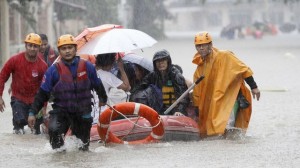From BBC News | On August 7th, 2012

At least nine people have been reported dead as torrential rain caused flooding that paralyzed most parts of the Philippine capital, Manila.
The flooding – neck-deep in some areas – forced tens of thousands of people to flee their homes, closing schools, offices and the stock exchange.
Nine members of one family died after a landslide hit shanty houses in Quezon City, a government report said.
More than 50 people died when Typhoon Saola struck more than a week ago.
Widespread flooding has been reported in the capital and the surrounding provinces, according to a statement from the National Disaster Risk Reduction and Management Council.
It said “the south-west monsoon enhanced by Tropical Storm ‘Haikui’ located 300km [184 miles] north-east of Taiwan” was expected to bring more rain.
“Expect landslides and flash floods in mountainous areas and floods in low-lying areas.”
President Benigno Aquino met civil defense officials to discuss the situation. “Everybody who is supposed to do something is doing what he is supposed to do,” he said.
The severity of the rain since Monday afternoon – in an already saturated city – has led officials to issue the highest level of alert, says the BBC’s Kate McGeown in Manila. “What worries many people here is that it has been raining almost continuously for more than 24 hours now. That is what caused such bad floods after Typhoon Ketsana in 2009. This time, the government is better prepared – tens of thousands of people have been evacuated. But many do not want to leave, especially if they cannot take their belongings. I’ve seen one family going repeatedly back into the floodwaters to salvage all they could.”
Casualties
Four members of another family were rushed to hospital in the landslide that killed the family in Manila’s Quezon City, according to the government’s disaster council.
“This is where my house used to be, this one is the end of our fence,” Jessie Bailon, one of those affected by the landslide, was quoted by the Associated Press news agency as saying.
He said that his wife, two children and one grandchild were still missing.
Another resident said that “the ground was shaking” and that he barely made it before the landslide hit his home.
A local police official was also quoted as saying that four people had drowned in another province, but this has not been confirmed.
Weather officials warn that the floods could get worse as the overflowing La Mesa dam, which holds back Manila’s main reservoir, spills more water.
“If we put it in a percentage, at least 50% of Metro Manila is flooded,” Jean Navarez, from the state weather service, was quoted by AFP as saying.
Residents living in slums and shanty towns on low ground have taken shelter in community buildings, reports said.
Several key roads were impassable and power had also been cut in some areas, mostly as a precaution, officials said.
Dams and waterways in affected areas are also being closely monitored. Rescue efforts are now underway to help stranded residents.
“As of now, it’s difficult to rescue the trapped residents, as we are battling strong currents with our life crafts,” police rescuer Eric Baran told Reuters news agency.
“It’s been raining continuously for over 24 hours now,” resident Justin Robertson told the BBC from Quezon City.
“We live on a hill and at the bottom of the hill there is a junction which is covered in water. Most offices and schools are closed today and we’ve decided to remain indoors as the main roads are either flooded or blocked with broken down vehicles.”







